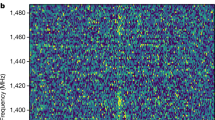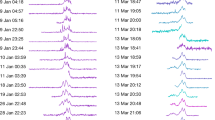Abstract
Hercules A is a powerful, double radio source, about 0.5 Mpc across. Although its two lobes differ, they share a family resemblance in overall form. Along the axis of the somewhat weaker west lobe, however, a unique structure is found: a regular sequence of broken circular rings of enhanced radio intensity. The five rings fit a simple kinematic model in which the rings are projected spherical shells of higher radio brightness. They grew as spherical waves with a uniform speed of expansion, all from one common place of origin, roughly where the narrow input jet widens sharply. The shells drift one after another outward at constant speed with the radiating medium of the lobe. Here we propose a model of inelastic proton–proton collisions within dense filamentary condensations of the input jet for the five initiating particle bursts. Source development contrasts sharply with that inferred for the prototype radio double, Cygnus A, where the radio lobe is nearly stationary and the electrons are newly energized at the outermost end of the lobe. The two sources point to quite distinct mechanisms for generating large radio-emitting plasmas.
This is a preview of subscription content, access via your institution
Access options
Subscribe to this journal
Receive 51 print issues and online access
$199.00 per year
only $3.90 per issue
Buy this article
- Purchase on Springer Link
- Instant access to full article PDF
Prices may be subject to local taxes which are calculated during checkout
Similar content being viewed by others
References
Dreher, J. W. & Feigelson, E. D. Nature 308, 43–45 (1984).
Morrison, P., Roberts, D. & Sadun, A. Astrophys. J. 280, 483–490 (1984).
Perley, R. A., Dreher, J. W. & Cowan, J. J. Astrophys. J. Lett. 285, L35 (1984).
Spinks, M. J., Rees, W. G. & Duflet-Smith, P. J. Nature 319, 471–473 (1986).
Myers, S. T. & Spangler, S. R. Astrophys. J. 291, 52–59 (1985).
Högbom, J. A. Astr. Aslrophys. 36, 173–192 (1979).
Author information
Authors and Affiliations
Rights and permissions
About this article
Cite this article
Mason, A., Morrison, P. & Sadun, A. The radio rings of Hercules A. Nature 333, 640–642 (1988). https://doi.org/10.1038/333640a0
Received:
Accepted:
Issue Date:
DOI: https://doi.org/10.1038/333640a0
Comments
By submitting a comment you agree to abide by our Terms and Community Guidelines. If you find something abusive or that does not comply with our terms or guidelines please flag it as inappropriate.



